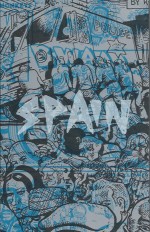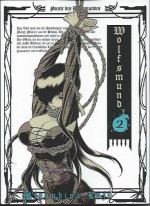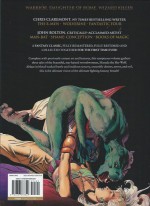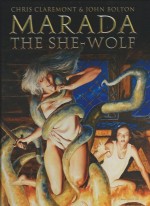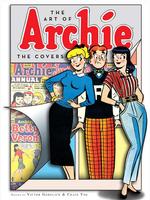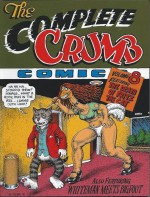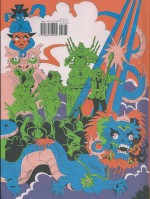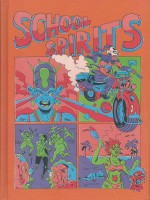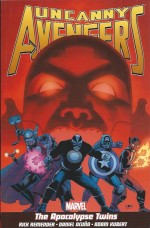
By Rick Remender, Gerard Gorman Duggan, Daniel Acuña & Adam Kubert (Marvel/Panini UK)
ISBN: 978-1-84653-564-2
In the aftermath of the Avengers versus X-Men publishing event, company-wide reboot MarvelNOW! repositioned and recast the entire continuity in the ongoing never-ending battle to keep old readers interested and pick up new ones.
What You Need to Know: Once upon a time mutant Avenger Wanda Maximoff – daughter of arch-villain Magneto and known to the world as the Scarlet Witch – married android hero The Vision and they had (through the agency of magic and her unsuspected chaos-energy fuelled ability to reshape Reality) twin boys. Over the course of time it was revealed that her beloved sons were not real and they subsequently vanished (for further details see Marvel Platinum: the Definitive Avengers).
As years passed her loss slowly drove Wanda mad, and when she finally slipped completely over the edge the resultant slaughter-spree destroyed many of her Avengers team-mates. The effects of her actions subsequently reshaped the entire Marvel Universe, resulting in climactic reboot Avengers Disassembled.
The team had barely recovered from that catastrophe before she overwrote Reality again, altering recent Earth history such that mutants ruled over a society where humans or “sapiens†were an acknowledged evolutionary dead-end living out their lives and destined for extinction within two generations.
It took every champion on Earth and a huge helping of luck to put that genie back in a bottle (another colossal crossover – House of M), and in the aftermath less than 200 mutants were left on Earth…
The Witch was partially rehabilitated and began her quest for redemption during the aforementioned Avengers versus X-Men with the World’s Mightiest Heroes striving against the remaining mutants for control of Hope Summers: a girl born to be mortal host to the implacable force of cosmic destruction and creation known as The Phoenix.
However the primal phenomenon instead possessed a quintet of X-Men, corrupting them by manifesting their dream of making Earth a paradise for besieged, beleaguered Homo Superior.
In the ensuing conflict humanity was briefly enslaved before, inevitably, the selfish appetites of the Phoenix Force caused those possessed to turn upon each other. Soon its transcendent power transformed rallying figurehead and mutant freedom-fighter Cyclops into another apparently unstoppable, insatiable “Dark Phoenixâ€.
At that crossroads moment his beloved mentor Charles Xavier, founder of the X-Men and formulator of the aspiration of peaceful mutant/human co-existence returned, only to be killed by his most devoted disciple…
Professor X’s death united X-Men and Avengers but, in the days following the expulsion of the Phoenix Force, progress and reconciliation stalled. The mostly human world festered with resentment even as new mutants began to manifest, and liberated mankind again fell into its old habits: intolerance, violence and bigoted, vigilante outrages…
When undying über-Nazi the Red Skull stole Xavier’s brain and appropriated the deceased mutant’s awesome telepathic abilities, his terrorist outrages were halted by a new team of Avengers: one formed by Captain America and S.H.I.E.L.D. to counter the rising tide of inter-species hostility…
Having been born out of one wave of genocidal race-hatred, the Sentinel of Liberty was painfully aware that America’s mutant minority had been poorly served – if not actively institutionally discriminated against – and sought to make amends by continuing Xavier’s utopian vision. To that end he convened the high-profile, affirmatively-active Avengers Unity Division, comprising human and mutant heroes working together.
The quintessential Avenger chose former government agent Havok (Cyclops’ brother Alex Summers) to lead the team, which consisted of himself, Thor, Scarlet Witch, Rogue, Wolverine, Sunfire,and the squad’s bloody baptism of fire saw them stop the Skull’s freakish army of bio-engineered S-Men and seemingly prove the promise of the premise.
However at a very public press conference inducting two new members – Wonder Man and the Wasp – they were attacked by ancient enemy Grim Reaper. The clash ended when mutant Rogue slaughtered the psychopath in full view of the horrified watching world. In one shocking instant the entire enterprise seemed utterly undermined with all that hard-won pro-mutant progress wasted…
Collecting Uncanny Avengers #6-11 (cover-dated June to October 2013), and the spin-off Uncanny Avenger AU #8 (July), this astounding celebration of the magic of Fights ‘n’ Tights fiction kicks everything into time-busting cosmic overdrive as the harried heroes fall prey to the bewildering machinations of arch-nemesis Kang the Conqueror and his most potent pawns The Apocalypse Twins…
It all begins in Scandinavia in 1013AD where/when a young, cocky and rebellious Thor is attacked by En Sabah Nur, immortal mutant Apocalypse and agent of the all-powerful Space Gods dubbed Celestials. The grotesque creature believes he is safeguarding the future by promoting the triumph of only the very strongest mutants, but all the petulant Thunderer knows is that he has been shamed and thrashed by a freak with an unfair advantage – star-forged armour…
Apocalypse is guided in his seemingly random attacks by former enemy Pharaoh Rama-Tut who advocates pre-emptive attacks on certain beings: those whose descendents would one day unite to resist the mutant advocate of Survival of the Fittest: the ancestors of a group called Avengers…
In Asgard Thor learns that his father Odin is subject a non-aggression pact with the Celestials but is too headstrong and angry to put aside his grievance. When sternly told to drop the matter, the furious godling finds suspiciously handy help from his malevolent half-brother Loki who shows him a spell which can enchant Thor’s battle-axe JarnBjorn into a weapon capable of rending even Celestial armour…
Delighted with his new unstoppable blade, Thor goes looking for a rematch and does not see that a stranger has been masquerading as his brother…
The Storm Lord arrives in primitive London just as Apocalypse attacks the next name on Rama-Tut’s list; a warrior named Folkbern Logan…
The Pagan soldier has been attacked by Apocalypse’s Four Horsemen and Thor is the answer to his prayers, wielding JarnBjorn with devastating effect. Saving Logan, destroying the servants and grievously wounding Apocalypse he returns to Asgard only to be severely admonished by Odin, even as elsewhen Apocalypse realises he has been played for a fool by Rama-Tut. The real winner is Kang who quietly takes his intended prize – a weapon even Space Gods cannot endure…
In our present, Apocalypse has been recently killed and many deadly creatures vie for the dubious honour of assuming his mantle and role as mutant messiah/exterminator of humanity. Thus on solar-orbiting Starcore Station his appalling son Genocide petitions the Celestials to accept him as their new agent…
The Celestials are a crucial component in the mechanics of the cosmos, their only interest being the raw, unstoppable processes of evolution. However when the enigmatic Apocalypse Twins materialise, they exercise their claim as true heirs by using JarnBjorn to achieve the impossible: executing the omnipotent Celestial Gardener and thereby endangering the very fabric of existence…
On Earth Havok has just successfully defended Rogue from murder charges at a S.H.I.E.L.D. hearing and attempts to keep her busy and out of sight by sending her after Magneto when news arrives that Earth’s alien early warning satellite The Peak is under attack.
Wanda meanwhile is trying to talk with WonderMan. Their relationship has been strained ever since she killed and resurrected him and the traumatised energy being is undergoing a few confusing life-changes. For one thing he’s now become a pacifist. He will help the team in every way possible… except by fighting…
Despite all efforts the Avengers are unable to save The Peak from the Twins, who use the fallen Celestial’s vehicle to send the station crashing down on Rio de Janeiro. Although Thor and Sunfire are able to save the city from obliteration the rest of the team are more concerned with a secret they have just uncovered: Wolverine’s hidden role in the death of the Twin’s birth-father – the former X-Man Warren Worthington, AKA Archangel…
Whilst all this is occurring Captain America is fighting for his life in war-torn South Sudan and manoeuvred into uncovering a message from a mysterious ally purporting to know what is actually going on.
The Twins are also aware of layers of deceit. Raised by Kang in time-warped isolation Eimin and Uriel are beginning to suspect their patron’s motives and each other’s dedication. These qualms do not prevent them from detonating an atomic blast just as the rest of the Avengers arrive to supplement Thor and Sunfire…
The Marvel Universe is a busy place and whilst this saga was unfolding another major event was simultaneously unfolding in the pages of Age of Ultron. There, a time-warping event created an alternate Earth where the malign mechanoid took over the world from a point in Earth’s future. The epic spawned a plethora of “extra†issues – such as Uncanny Avengers #8AU – wherein the characters from the alternate timeline spawned by the temporal tribulations offered decidedly different tales of our most famed champions.
In this chronal digression – written by Gerard Gorman Duggan and illustrated by Adam Kubert – we glimpse the formative years of the Apocalypse Twins as Kang temporarily frees his twisted children from his private concentration camp in 4145AD. The Lord of Time had been raising them in such harsh conditions to temper them for future roles, but now seeks to test his charges with a first mission of assassination.
The target is veteran Red, White and Blue Sentinel of Justice Colonel America but the operation does not go according to plan…
Returning with #9 to the regularly scheduled tale Ragnarok Now! displays the deepening rift in the Unity team as the resurgent adult Apocalypse Twins continue their campaign for mutant ascendancy by constituting their own squad of Horsemen to winnow humanity and its heroes. These heralds of Mutant Rapture and human disaster are not the bio-engineered creatures their true father preferred however.
The children of En Sabah Nur instead opt for a quartet of dead horrors to pave their way to triumph…
In Sudan meanwhile, Captain America digests information received from the godlike Immortus – another “master of time†and purportedly Kang’s reformed future self. The decidedly untrustworthy savant has entrusted the Star Spangled Avenger with the actual nature of reality and revealed why the Twins must be stopped as well as the ghastly consequences should they win the ongoing war to control all times, spaces and realities…
When Cap then learns of Wolverine’s murderous past actions the team splits over philosophy and pragmatism. Havok is hard-pressed to keep the heroes united before the onslaught of the Twins’ zombie Horsemen, Sentry, Banshee, Daken and Grim Reaper: all deadly killers with deep emotional ties to the heroes and all of whom died at the hands of Avengers…
As the Unity squad splits up to tackle the Apocalypse agents, the calamitous clashes only mask the Twins’ secret agenda: they have seemingly seduced the reality-shredding Scarlet Witch to their cause, convincing her to use her world-warping curse to bring about their long-desired ascendancy as instigators of the Mutant Rapture…
To Be Continued…
Scripted by Rick Remender and illustrated by Daniel Acuña, this rather confused and somewhat convoluted, but exceedingly spectacular, complex and ambitious epic may be a bit daunting for casual readers but dedicated followers of mutant mayhem will no doubt adore the fantastic premise and blockbusting scope of events.
Also provoking much applause and approbation are a gallery of covers and variants by John Cassaday & Laura Martin, Milo Manara and Jim Cheung, whilst the selection of 21st century extra content in the form of AR icon sections includes trailers, character bios, creator commentaries and oodles more. The Marvel Augmented Reality App pages grant access to story bonuses once you download the little dickens – free from marvel.com – onto your smart-phone or Android-enabled tablet. So you should do that too, right?
™ & © 2013 Marvel & Subs. Licensed by Marvel Characters B.V. through Panini S.p.A. All rights reserved. A British Edition published by Panini Publishing, a division of Panini UK, Ltd.

